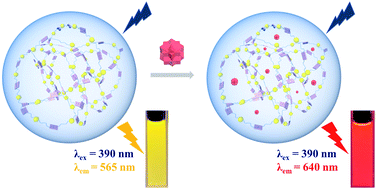Efficient artificial light-harvesting system constructed from supramolecular polymers with AIE property†
Abstract
Supramolecular luminescent materials in water have attracted much interest due to their excellent tunability, multi-color emission, and environment-friendly behavior. However, hydrophobic chromophores are often affected by poor solubility and aggregation-caused quenching effects in aqueous media. Herein, we report a water-phase artificial light-harvesting system based on an AIE-type supramolecular polymer. Specifically, dispersed nanoparticles in water were prepared from an AIE chromophore-bridged ditopic ureidopyrimidinone (M) based supramolecular polymer with the assistance of surfactants. By co-assembling the hydrophobic chromophores NDI as energy acceptor into the nanocarriers, artificial light-harvesting systems (M–NDI) could be successfully constructed, exhibiting efficient energy transfer and high antenna effects. Furthermore, the spectral emission of the system could be continuously tuned with a relatively small number of acceptors. This work develops an efficient supramolecular light-harvesting system in water, which has potential applications in dynamic luminescent materials.

- This article is part of the themed collection: Emerging Investigators Series


 Please wait while we load your content...
Please wait while we load your content...